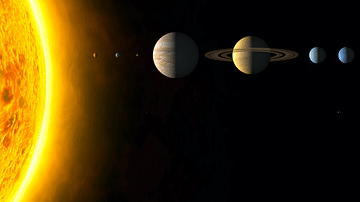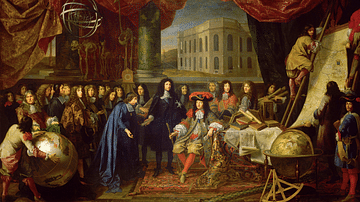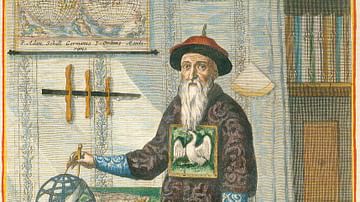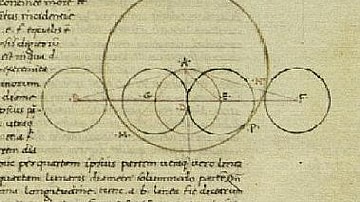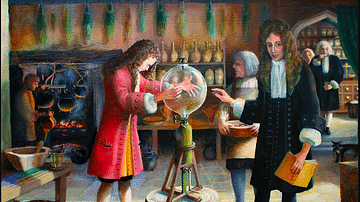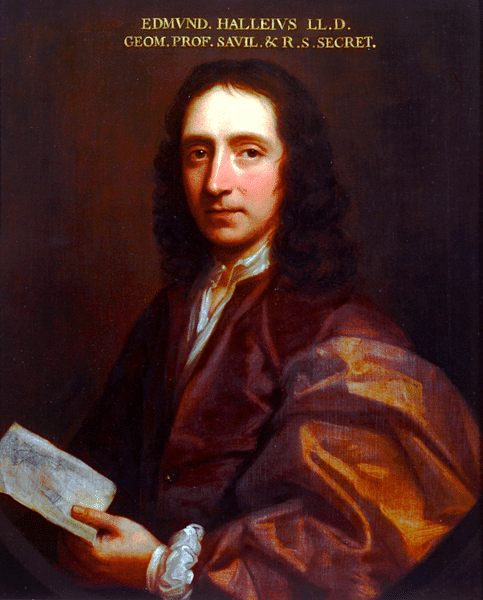
Edmond Halley (1656-1742) was an English astronomer, mathematician, and cartographer. Halley's Comet is named after him since he accurately predicted its return in 1758. One of the early globetrotting scientists, Halley led several maritime expeditions to far-flung places to compile reliable data on the Earth's magnetic field. He also invented a diving suit and pioneered a working diving bell.
Early Life
Edmond Halley (also spelt Edmund) was born near London on 8 November 1656. The Halley family derived its wealth from business interests in the capital. Edmond attended Queen's College, Oxford from 1673, but he never completed a degree, preferring instead to go globetrotting in late 1676. Interested in science from a young age, Halley was in regular correspondence with the Royal Astronomer John Flamsteed (d. 1719). Halley was just 19 when he sent his first research paper to the Royal Society, a work examining how to calculate the orbits of the planets. It was his hands-on approach to getting data from remote places that would establish him as one of the leading scientists of the Scientific Revolution.
Halley on St. Helena
Observation of the heavenly bodies required observatories. The Greenwich Observatory was founded in 1675, and Halley worked here for a time, but many more observation posts were needed, preferably in very different locations so that readings could be compared and made more accurate. Further, the southern stars were much less well-known than the northern stars under the observation of the Greenwich astronomers. Consequently, Halley sailed to the island of St. Helena in the South Atlantic, arriving there in 1677. The expedition was funded by the English treasury, and a ship was provided by the East India Company (EIC). Tiny volcanic St. Helena, then owned by the EIC, was the only British-held territory in the southern hemisphere. In an age of growing global empire and trade, both the treasury and the EIC were greatly interested in improving navigational accuracy. In addition, the expedition was favoured by Charles II of England (r. 1660-1685).
Halley established an observatory on St. Helena and proceeded to take observations over a period of two months. The island's notorious ability to attract cloud cover did not help Halley's project, but enough readings were taken so that he could make the first chart of the stars of the Southern Hemisphere based on observations made via telescope. The chart set the position of 341 stars. Other notable work on St. Helena included Halley's readings of atmospheric pressure using a mercury barometer, a detailed observation of a total lunar eclipse, and a rare observation of the transit of Mercury across the Sun. In an example of the ever-more frequent cooperation between international scientists, the latter readings were later compared with those taken by French astronomers who observed the same phenomenon from Avignon. Halley published his St. Helena work in 1678, and he was consequently made a fellow of the Royal Society at the tender age of 22. Halley's scientific career was launched, and like a supernova, it would sparkle for a very long time.
Halley's open atheism did not seem to be an obstacle to progress in the society since he later became a member of its council and was appointed its clerk in 1686. Another area of indifference for Halley was politics, and in these two ways, he was very much like a modern scientist: willing to pursue his research wherever in the world was deemed necessary with no particular loyalty to anything except scientific truth.
Halley in Danzig
In 1679, Halley visited the observatory in Danzig (Gdańsk) and swapped notes with the celebrated astronomer Johannes Hevelius (1611-1687). He had been sent there by the Royal Society, but Halley had low expectations since Hevelius was one of the last of the astronomer dinosaurs, still not using any telescopic sights on his instruments despite the telescope having been perfected by Galileo Galilei (1564-1642) back in 1608 and then improved with sight measuring devices. Still, Hevelius had made several important discoveries in his long career, and he had the distinction of being the first foreign fellow of the Royal Society. The society had sent Halley to Danzig to try and persuade Hevelius to use the latest instruments, but Halley was likely pleasantly surprised to find out that when using his own telescope he realised Hevelius' readings were remarkably accurate. Halley returned home but stopped in Paris on the way to compare yet more astronomical observations, this time with Gian Domenico Cassini (1625-1712), famed for identifying the spaces in the rings of Saturn a few years before.
Halley's Comet
Halley was greatly interested in comets, once thought to be omens of impending disaster. A bright comet was observed in 1682. Halley, looking into the matter some 13 years later, realised that, given the similarity of descriptions by past astronomers, this was the same comet that had been observed in 1607 and 1531. This was a new idea for Europe, but Chinese astronomers had long known that comets follow a fixed orbit and so return periodically. The German astronomer Joseph Kepler (1571-1630) had in 1609 presented the theory that planets move around the Sun in an elliptical orbit. Halley suggested that comets did the same. Halley, therefore, predicted the path of this 1682 comet, which meant that it would again be visible in the night sky in 1758 and thereafter every 75 years or so. He published this prediction in his 1705 work Synopsis of the Astronomy of Comets, which covered many other comets with observational records. Halley then revised his prediction in 1717 to the end of 1758 or early 1759. When 1758 came around and so did the comet (on Christmas Day of all days), the by-now-deceased Halley was confirmed in his bold prediction. The comet was duly named after Halley in recognition of his mathematical achievement. Halley's Comet was last seen in 1986, and it will next appear in our night skies in 2061.
Halley and his contemporaries at the Royal Society had long pondered what might happen if a comet hit the Earth. It was speculated that stories such as the Great Flood of the Bible may have been caused by a comet strike. In this category, there was another comet which preoccupied Halley, the one sighted in 1680, which was much brighter and therefore larger than 'Halley's comet'. Both Isaac Newton (1642-1727) and Halley agreed that this comet, which followed a much larger orbit than Halley's, would next pass the Earth 575 years later (in 2255). Further, both scientists believed the comet is headed on a collision course with the Sun. Newton wrote: "it might perhaps have five or six revolutions more first; but whenever it did, it would so much increase the heat of the sun that this earth would be burnt, and no animals in it could live" (Jardine, 40). Sunspots had been observed with care by Galileo, and it was the creation of a large one by this comet that these astronomers feared.
Other Work: Newton, Navigation & Statistics
In 1684, Halley helped Newton in his research on gravity. Halley encouraged his good friend to publish his findings, editing the text and providing the money to print Newton's Mathematical Principles of Natural Philosophy (Philosophiae Naturalis Principia Mathematica) in 1687. Halley was also busy in other areas, compiling tables of statistics that recorded mortality rates in the city of Wrocław (then called Breslau) in 1693, a useful precursor for population analysis, particularly for life insurance companies. Halley designed the first deep-sea diving suit (which he tested himself) and designed a diving bell in order to help relieve wrecks of their sunken treasure (especially Spanish ones). The wreck Halley himself tried to salvage goods from was the Guynie, which had belonged to the Royal African Company. The Guynie was carrying a large quantity of gold and ivory but sank off the coast of Sussex, England, in 1691. Halley devoted five years to the salvage project, which had indifferent financial results but at least made gains in diving technology. Halley described his diving bell in a Royal Society meeting, here summarised by L. Jardine:
The bell was five feet in diameter at the bottom (where it was open), three feet at the top, with a thick glass window, and a small cock for letting out foul air, and five feet deep. There was a bench for the divers to sit on, and he reported that he kept three men under water at 18 metres for an hour and three quarters…Halley brought down air to the bell in strengthened casks.
(221)
Halley also served for a time as deputy controller of the mint in Chester. Finally, Halley was curious about the effects of opium on the mind, and he became convinced it provided him with greater clarity of thought. He presented a paper on his opium research to the Royal Society in 1690. Halley was obviously a mix of clinical scientist and salty mariner since his other vices, noted by fellow astronomer John Flamsteed (1646-1719), included the excessive consumption of brandy, heavy smoking, and tendency to use at table language as blue as a lowly seaman might employ after a particularly difficult circumnavigation.
Halley's Trans-Atlantic Voyages
Halley was always trying to solve the age-old longitude problem, that is how to determine one's longitude on a long voyage before a reliable chronometer had been invented. Halley thought he could solve the problem by mapping the variations in the Earth's magnetic field, the idea being that with this information, a navigator could monitor his ship's compass (its deviation from true North) and know where he was. To compile his magnetic chart, Halley needed readings from far-flung places. With backing from the Royal Society and the Royal Navy, Halley himself wrote the expedition's ambitious objective: "to endeavour to gett full information of the Nature and Variation of the Compasse over the whole Earth, as Likewise to experiment what may be expected from the Severall Methods proposed for discovering the Longitude at Sea" (Jardine, 30).
In 1698, Halley crossed the Atlantic Ocean in the ship Paramore, which he himself captained (amazingly, he had no qualifications whatsoever for this maritime role). This would be the first of three trans-Atlantic voyages. The trio were the first of their kind since never before had science been the main objective, usually, it was for trade or territorial discovery. Halley took hundreds of readings up and down the Atlantic coast of the Americas, often in appalling weather conditions.
In 1700, Halley pulled all his research together and finally published his magnetic world map – covering the Atlantic Ocean and part of the Pacific Ocean – where "isogonic" lines showed the places with the same magnetic variation. The chart was proudly displayed in the meeting room of the Royal Society. Ever the budding cartographer, Halley also made charts that mapped trade winds and the tides of the English Channel. Alas, the magnetic chart did not erase the one flaw in Halley's navigational scheme, which was the extreme difficulty in measuring the declination of a compass. Even worse, the magnetic field is not stable, and so compass declination in a particular location can vary, even from one year to another. Still, Halley had the consolation that his work on magnetism and cartography secured him a professorship in geography at the University of Oxford in 1704 (he had missed out on a chair in astronomy back in 1691, probably because of his atheism).
The Atlantic voyages also gave Halley the distinction of having "traveled more extensively in the pursuit of scientific knowledge than any other major early modern scientist" (Burns, 127). In the course of his relentless search for data throughout his career, Halley had crisscrossed the English Channel from Cornwall to Kent and Brittany to Calais. He had toured France, Italy, and several Mediterranean islands. He had visited Central Europe from The Hague down to Bakar in Croatia, and he had visited Atlantic ports in the Americas from Rio de Janeiro to Newfoundland. This was a new type of scientist.
Later Career
In 1712, something of a rumpus broke out in the world of astronomy. Halley published data meticulously collected by John Flamsteed in the form of a star chart. Flamsteed felt unready to publish the data and that this was his own work derived from instruments he had funded personally. Halley was impatient to get the data published because it would be invaluable to the latest studies on gravity, and he considered Flamsteed a public servant, so, in this sense, his data belonged to everyone. Halley published Flamsteed's findings. Newton sided with Halley in what became a bitter and unsettled feud.
In 1714, Halley became editor of Philosophical Transactions, a magazine closely associated with the Royal Society. Under Halley's control, the magazine shifted its focus to mathematics and astronomy. As part of his role at Oxford, Halley worked on the subject of cones and an edition of Conics by the ancient Greek mathematician Apollonius of Perga (c. 262 to c 190 BCE). In 1715, Halley predicted the casting of shadow across southern England following a solar eclipse; he published a handy map of this phenomenon and was anxious to reassure people the event was not an omen against the new ruling monarchy in Britain, the House of Hanover led by King George I of Great Britain (r. 1714-1727).
Halley was appointed the Royal Astronomer in 1720, ironically, replacing his old rival Flamsteed, who had died earlier that year. Halley then refitted the Greenwich Observatory with the latest and most powerful telescopic equipment. In his role, Halley was expected to perfect the existing star charts so vital to the navigational success of the Royal Navy.
Legacy & Death
By the end of his career, Halley had collected a number of important discoveries besides his comet's orbit. Halley discovered the acceleration of the Moon. He showed that the work of the Arab astronomer Al-Battani (c. 850-929 CE) was accurate. He showed that it was possible to measure the distance between the Earth and the Sun by observing and measuring the transits of Venus across the latter body. Halley noted the movement of the stars in relation to each other (proper motion) in addition to the more well-known phenomenon of their changing relation to the Earth. Finally, Halley supported the ongoing research into the longitude problem, which was finally solved with Harrison's marine chronometer, invented and built by John Harrison (1693-1776). In 1729, Halley was invited to become a member of the prestigious Royal Academy of Sciences in France. This appointment illustrates that Halley was perhaps the most respected of all British scientists outside Britain.
Edmond Halley, one of the leading lights of the Scientific Revolution, died on 14 January 1742. Each subsequent generation has, of course, been reminded of his name and exploits in the service of science as his once-in-a-lifetime (or twice if you are lucky) comet flies past, a symbol of how the heavenly bodies march on relentlessly like pendulums swinging to a different measurement of time than that which preoccupies humanity.




